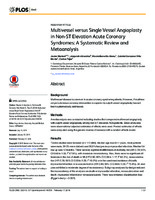Resumen:
Background: Multivessel disease is common in acute coronary syndrome patients. However, if multivessel percutaneous coronary intervention is superior to culprit-vessel angioplasty has not been systematically addressed.
Methods: A metaanalysis was conducted including studies that compared multivessel angioplasty with culprit-vessel angioplasty among non-ST elevation ACS patients. Since all studies were observational adjusted estimates of effects were used. Pooled estimates of effects were computed using the generic inverse of variance with a random effects model.
Results: Twelve studies were included (n = 117,685). Median age was 64.1 years, most patients were male, 29.3% were diabetic and 36,9% had previous myocardial infarction. Median follow-up was 12 months. There were no significant differences in mortality risk (HR 0.79; 95% CI 0.58 to 1.09; I2 67.9%), with moderate inconsistency. Also, there were no significant differences in the risk of death or MI (HR 0.90; 95% CI 0.69 to 1.17; I2 62.3%), revascularization (HR 0.76; 95% CI 0.55 to 1.05; I2 49.9%) or in the combined incidence of death, myocardial infarction or revascularization (HR 0.83; 95% CI 0.66 to 1.03; I2 70.8%). All analyses exhibited a moderate degree of inconsistency. Subgroup analyses by design reduced the inconsistency of the analyses on death or myocardial infarction, revascularization and death, myocardial infarction or revascularization. There was evidence of publication bias (Egger’s test p = 0.097).
Conclusion: Routine multivessel angioplasty in non-ST elevation acute coronary syndrome patients with multivessel disease was not superior to culprit-vessel angioplasty. Randomized controlled trials comparing safety and effectiveness of both strategies in this setting are needed
Descripción:
Fil: Mariani, J. Hospital de Alta Complejidad en Red El Cruce Dr. Néstor C. Kirchner. Servicio de Cardiología. Florencio Varela, Argentina.

